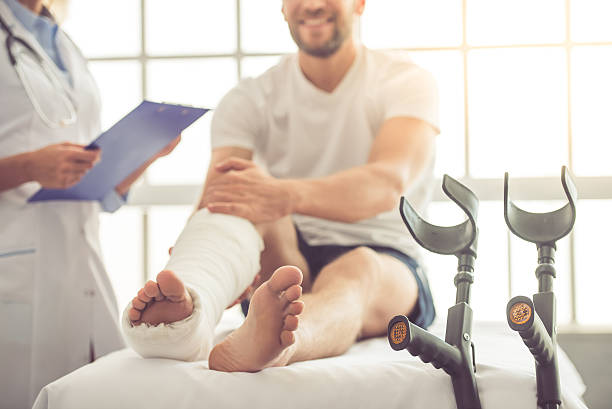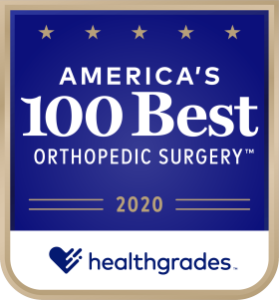 Orthopedic doctors have up to 14 years of medical training, including four years of undergraduate studies and four years of medical school. Training may include traditional medical school (a doctor of medicine degree or MD) or osteopathic education (a doctor of osteopathy degree or DO). (“Orthopedist: Medical Definition, Expertise & Specialties”)
Orthopedic doctors have up to 14 years of medical training, including four years of undergraduate studies and four years of medical school. Training may include traditional medical school (a doctor of medicine degree or MD) or osteopathic education (a doctor of osteopathy degree or DO). (“Orthopedist: Medical Definition, Expertise & Specialties”)
They must complete an orthopedic residency that is typically five years and provides specialized hands-on training in a medical setting. Orthopedists who wish to subspecialize complete an additional one- or two-year fellowship.
Orthopedic subspecialties include:
- Foot and ankle surgery.
- Hand and upper extremity surgery.
- Joint replacement
- Orthopedic oncology, which includes tumor and cancer care.
- Orthopedic trauma.
- Pediatric orthopedic surgery.
- Spine surgery.
- Sports medicine.
Once their medical training is complete, orthopedists can become board certified by passing an exam from a certified organization like the American Board of Orthopaedic Surgery or the American Osteopathic Board of Orthopedic Surgery. Orthopedic doctors continue to advance their knowledge through regular continuing medical education courses.
What do orthopedic doctors do?
 Orthopedic doctors treat patients of all ages – from newborns to the elderly. Orthopedic doctors specialize in the musculoskeletal system, including muscles, nerves, bones, joints, tendons, ligaments, cartilage, and other connective tissue. An orthopedic doctor evaluates, diagnoses, and treats musculoskeletal structures when injured or affected by illness. Orthopedic doctors also help prevent musculoskeletal injuries and conditions from developing in the future.
Orthopedic doctors treat patients of all ages – from newborns to the elderly. Orthopedic doctors specialize in the musculoskeletal system, including muscles, nerves, bones, joints, tendons, ligaments, cartilage, and other connective tissue. An orthopedic doctor evaluates, diagnoses, and treats musculoskeletal structures when injured or affected by illness. Orthopedic doctors also help prevent musculoskeletal injuries and conditions from developing in the future.
What conditions do orthopedic doctors diagnose?
Orthopedic physicians diagnose and treat countless musculoskeletal conditions, including:
- Arthritis
- Bone Tumors
- Carpal Tunnel Syndrome
- Hip Dysplasia
- Muscular Dystrophy
- Neurofibromatosis
- Osteoporosis
- Runner’s Knee
- Sciatica
- Tennis Elbow
Joint pain, stiffness, and swelling can decrease the range of motion. Daily tasks like showering, cleaning, walking, and bending over become more difficult when this occurs. Orthopedic physicians help improve range of motion through non-surgical or surgical treatments.
Physical therapy, exercise programs, analgesics (such as acetaminophen), non-steroidal anti-inflammatory drugs, and injections are all treatment possibilities for acute pain. Surgery may be the appropriate treatment option for those suffering from more severe pain. Surgeries could include arthroplasty (replacement), arthroscopy, soft tissue, and cartilage repair (Tucker).
Treat and prevent injuries
In addition to treating musculoskeletal conditions, orthopedic doctors diagnose and treat injuries caused by sports, physical activity, trauma, overuse, and aging.
Broken bones, compression fractures, stress fractures, dislocations, muscle injuries, and tendon tears or ruptures are common injuries that orthopedic doctors treat. Orthopedic doctors can also make treatment and prevention plans to help patients avoid future injuries. Athletes will often work with orthopedists to help prevent future injuries and optimize performance.
In addition to treating orthopedic injuries when they occur, orthopedic specialists and surgeons
treat chronic after-effects of traumatic injuries, including:
- Fractures that did not heal or are delayed in healing
- Bone or joint conditions resulting from fractures that did not heal in the correct alignment
- Joint deformity from arthritis
- Infections
Diagnosis
Various tests can be used to diagnose and screen for orthopedic conditions.
Standard orthopedic tests include bone densitometry, skeletal scintigraphy, discography, myelography, and electromyography. Most of these tests rely on proven technology, such as X-ray, MRI, ultrasound, and computed tomography. Other tests, such as flexibility, stress, muscle, and gait analyses, may be used to assess range of motion or identify abnormalities in skeletal alignment or muscle function. Additional tests, including muscle biopsy and bone marrow biopsy, may be needed in some instances to help narrow down the diagnosis (“Diagnosis and Screening for Orthopaedic Conditions”).
It is essential for the orthopedic doctor to complete the proper testing and diagnostics to ensure they have a clear understanding of your specific conditions. The experts at Great Lakes Orthopedics have served the community for over 60 years and can diagnose and treat any musculoskeletal condition or injury you may be experiencing. Our board-certified orthopedic surgeons specialize in total knee and total hip replacements, shoulder surgery, sports medicine, pediatric orthopedics, and general orthopedics. Call (734) 422-8400 to schedule an appointment or request an appointment online.
Works Cited
“Diagnosis and Screening for Orthopaedic Conditions.” Johns Hopkins Medicine, https://www.hopkinsmedicine.org/health/treatment-tests-and-therapies/diagnosis-and-screening-for-orthopaedic-conditions. Accessed 25 March 2023.
“Orthopedist: Medical Definition, Expertise & Specialties.” Cleveland Clinic, 1 March 2022, https://my.clevelandclinic.org/health/articles/22472-orthopedist. Accessed 25 March 2023.
Tucker, Bradley. “Musculoskeletal Pain.” Penn Medicine, 21 August 2014, https://www.pennmedicine.org/updates/blogs/musculoskeletal-and-rheumatology/2014/august/what-is-musculoskeletal-pain. Accessed 25 March 2023.




